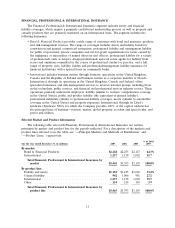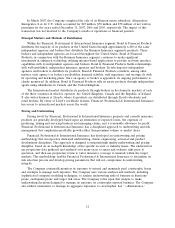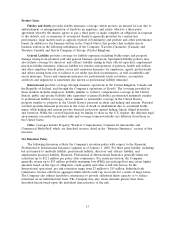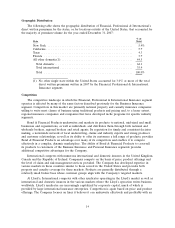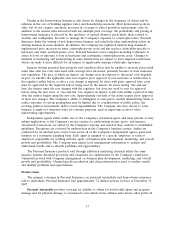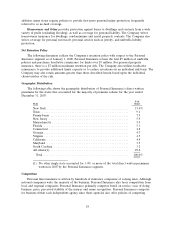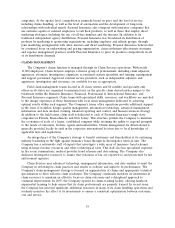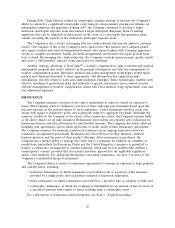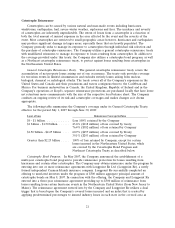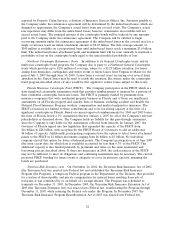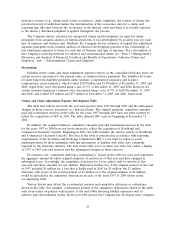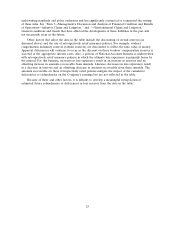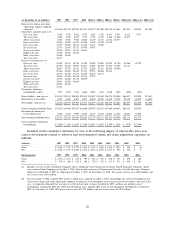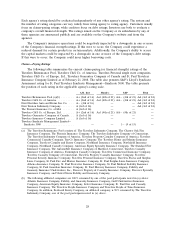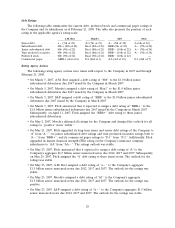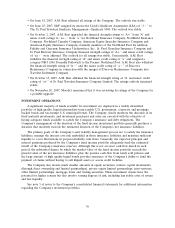Travelers 2007 Annual Report Download - page 32
Download and view the complete annual report
Please find page 32 of the 2007 Travelers annual report below. You can navigate through the pages in the report by either clicking on the pages listed below, or by using the keyword search tool below to find specific information within the annual report.During 2006, Claim Services refined its catastrophic response strategy to increase the Company’s
ability to respond to a significant catastrophic event using its own personnel, placing less reliance on
independent adjustors and appraisers. During 2007, the Company continued to develop a larger
dedicated catastrophe response team and trained a larger Enterprise Response Team of existing
employees who can be deployed on short notice in the event of a catastrophe that generates claim
volume exceeding the capacity of the dedicated catastrophe response team.
The Company is also a leader in bringing effective claim solutions that provide superior customer
service. One example of this is the Company’s auto claim service that features two Company-owned
auto repair facilities and selected independently-owned auto repair facilities with Company appraisers
on site to complete an estimate, handle all rental arrangements and monitor the repair process from
start to finish. By managing the claim in this way, the Company can help ensure prompt, quality results
and create a differentiated, superior claim experience for customers.
Another strategic advantage is TravCompSM, a workers’ compensation claim resolution and medical
management program that assists adjusters in the prompt investigation and effective management of
workers’ compensation claims. Innovative medical and claims management technologies permit nurse,
medical and claims professionals to share appropriate vital information that supports prompt
investigation, effective return to work and claim resolution strategies. These technologies, together with
effective matching of professional skills and authority to specific claim issues, have resulted in more
efficient management of workers’ compensation claims with lower medical, wage replacement costs and
loss adjustment expenses.
REINSURANCE
The Company reinsures a portion of the risks it underwrites in order to control its exposure to
losses. The Company cedes to reinsurers a portion of these risks and pays premiums based upon the
risk and exposure of the policies subject to such reinsurance. Ceded reinsurance involves credit risk,
except with regard to mandatory pools, and is generally subject to aggregate loss limits. Although the
reinsurer is liable to the Company to the extent of the reinsurance ceded, the Company remains liable
as the direct insurer on all risks reinsured. Reinsurance recoverables are reported after reductions for
known insolvencies and after allowances for uncollectible amounts. The Company also holds collateral,
including trust agreements, escrow funds and letters of credit, under certain reinsurance agreements.
The Company monitors the financial condition of reinsurers on an ongoing basis and reviews its
reinsurance arrangements periodically. Reinsurers are selected based on their financial condition,
business practices and the price of their product offerings. After reinsurance is purchased, the
Company has a limited ability to manage the credit risk to a reinsurer. In addition, in a number of
jurisdictions, particularly the European Union and the United Kingdom, a reinsurer is permitted to
transfer a reinsurance arrangement to another reinsurer, which may be less creditworthy, without a
counterparty’s consent, provided that the transfer has been approved by the applicable regulatory
and/or court authority. For additional information concerning reinsurance, see note 4 of notes to the
Company’s consolidated financial statements.
The Company utilizes a variety of reinsurance agreements to manage its exposure to large property
and casualty losses, including:
• facultative reinsurance, in which reinsurance is provided for all or a portion of the insurance
provided by a single policy and each policy reinsured is separately negotiated;
• treaty reinsurance, in which reinsurance is provided for a specified type or category of risks; and
• catastrophe reinsurance, in which the Company is indemnified for an amount of loss in excess of
a specified retention with respect to losses resulting from a catastrophic event.
For a description of reinsurance-related litigation, see Item 3, ‘‘Legal Proceedings.’’
20



